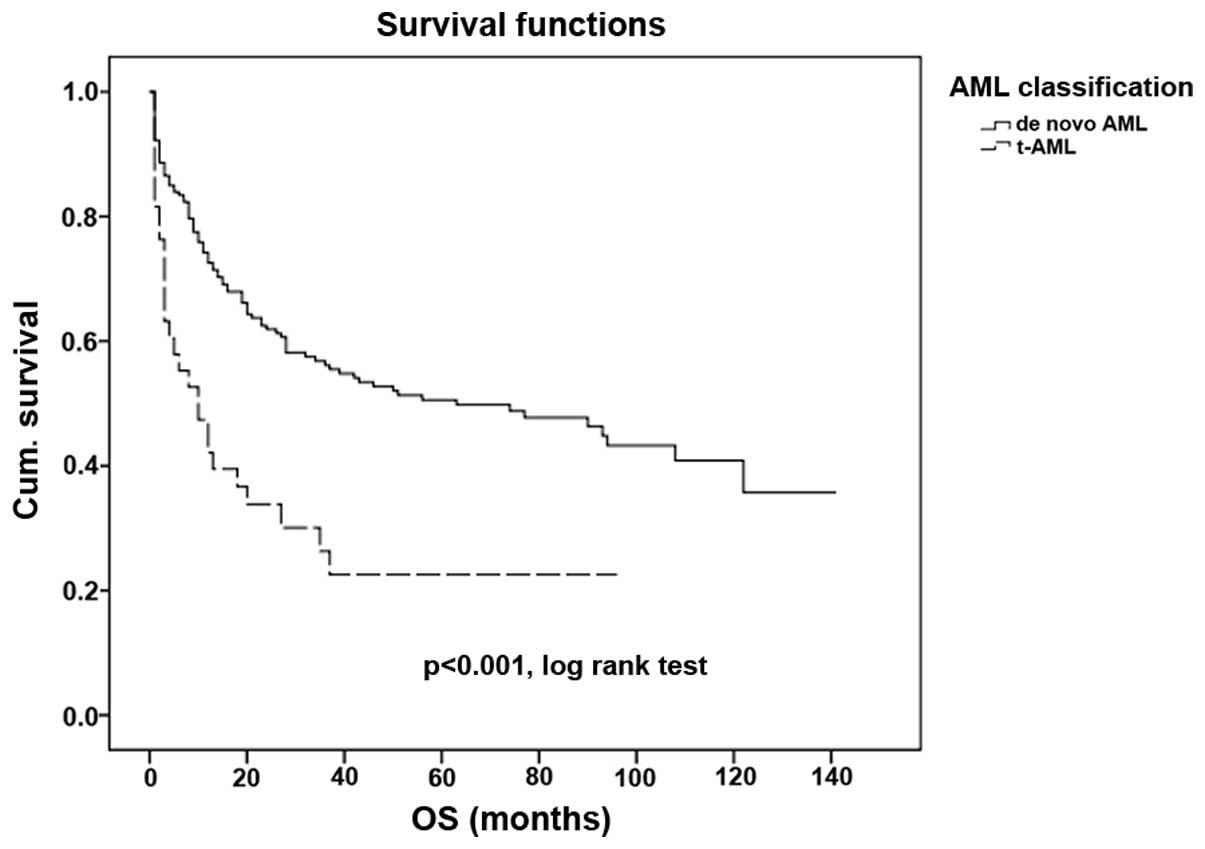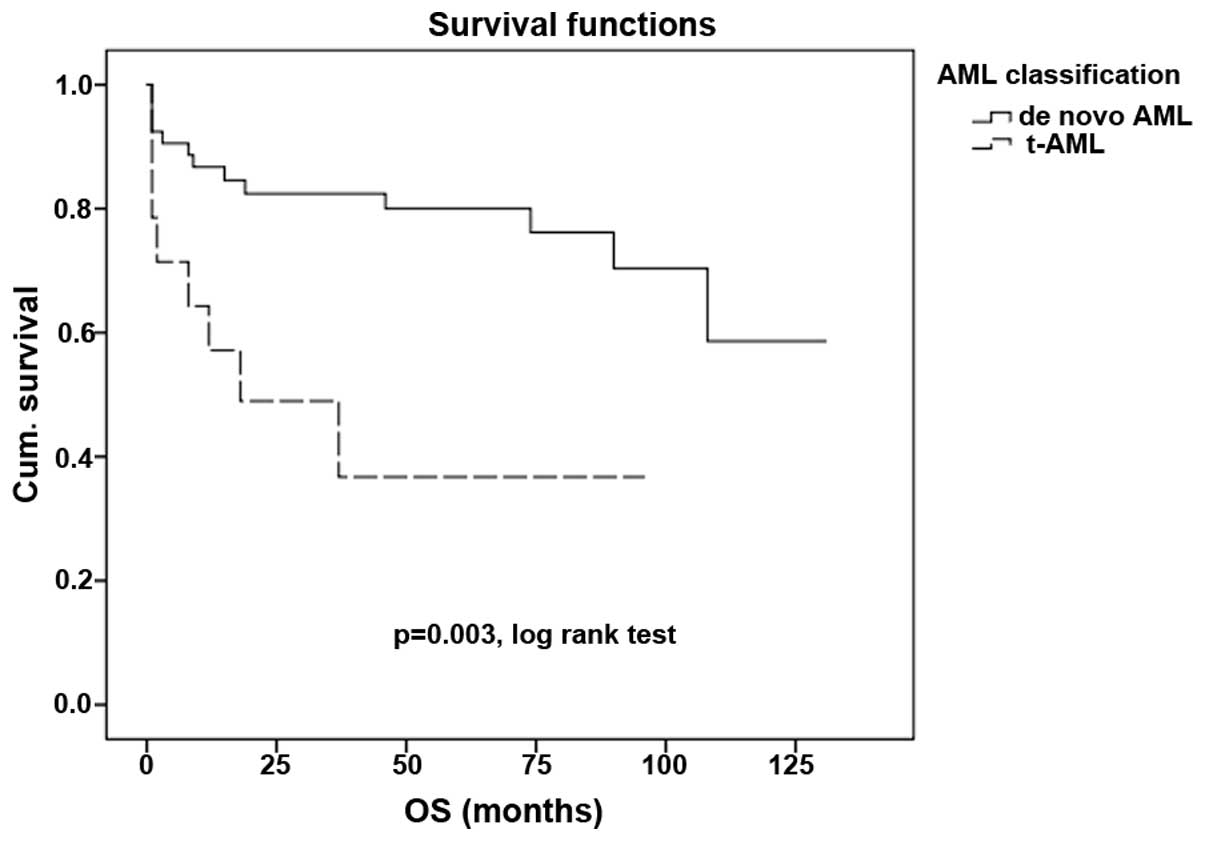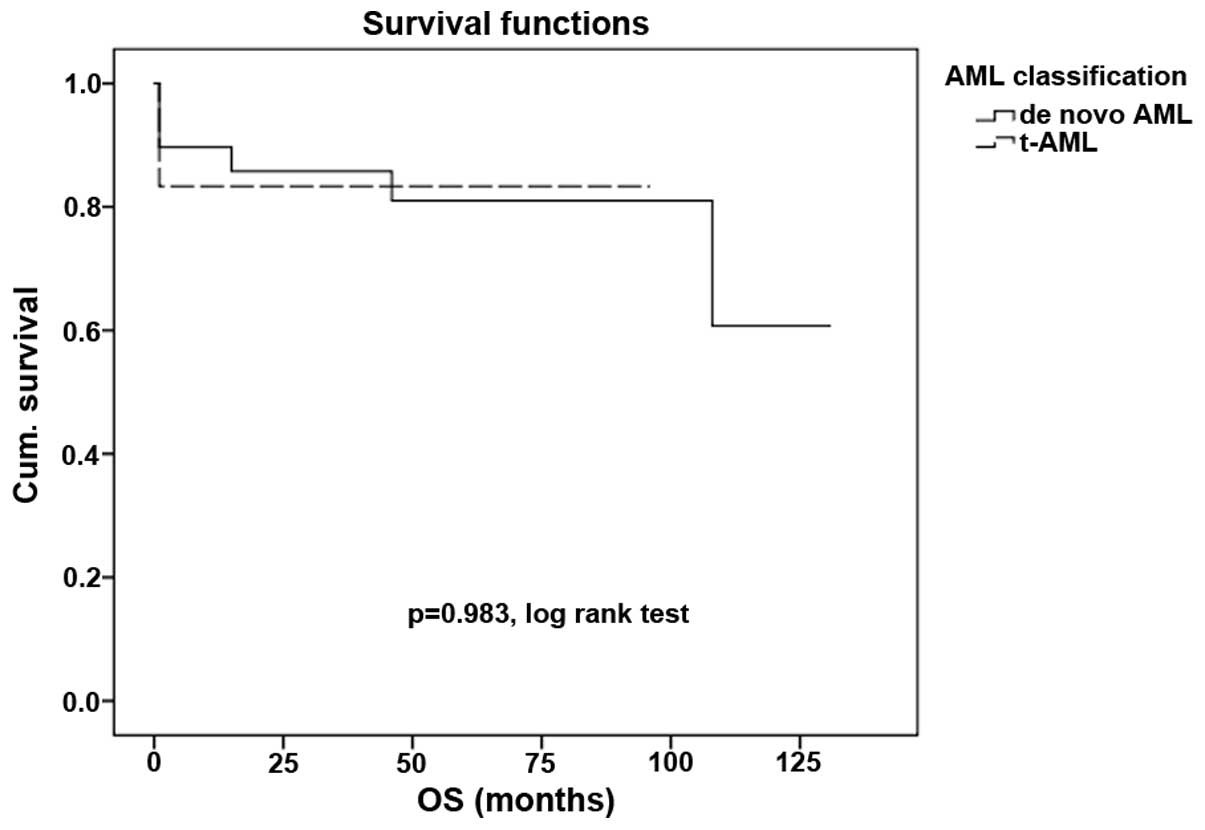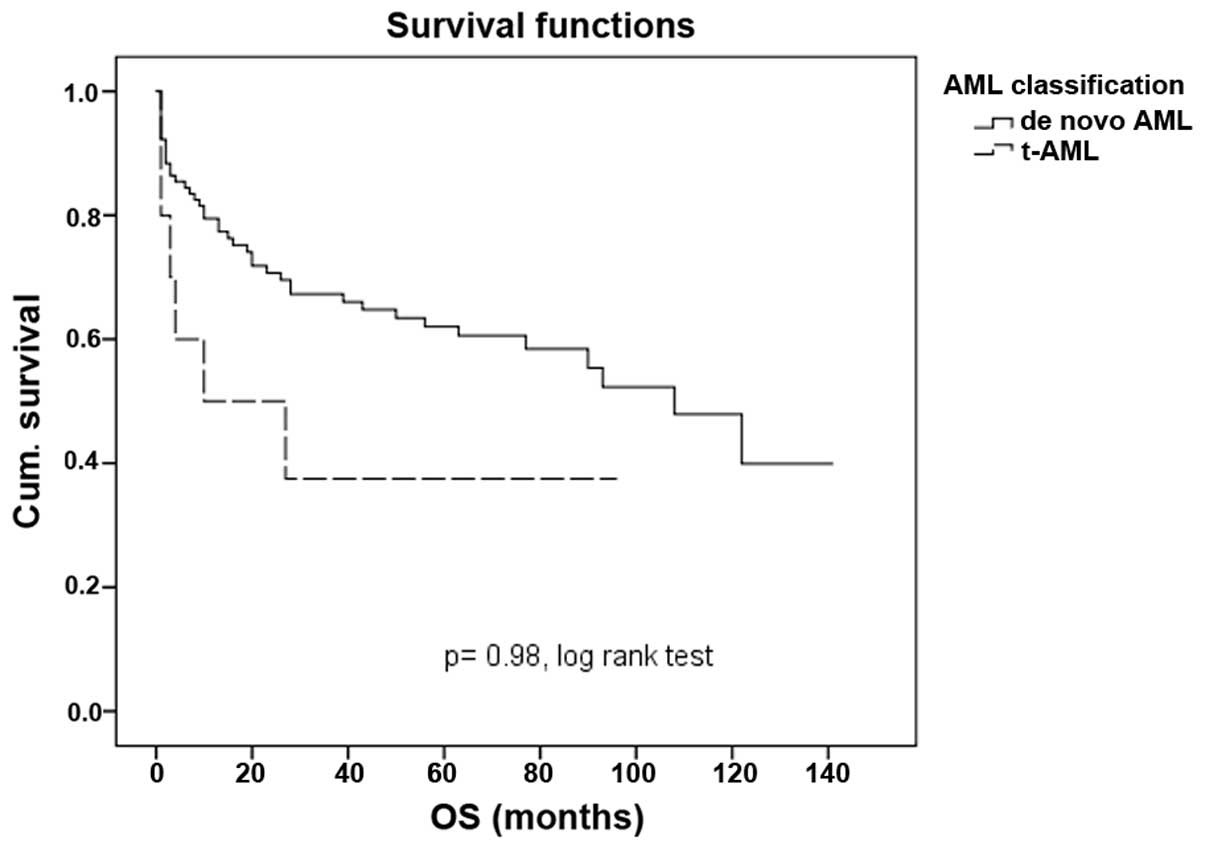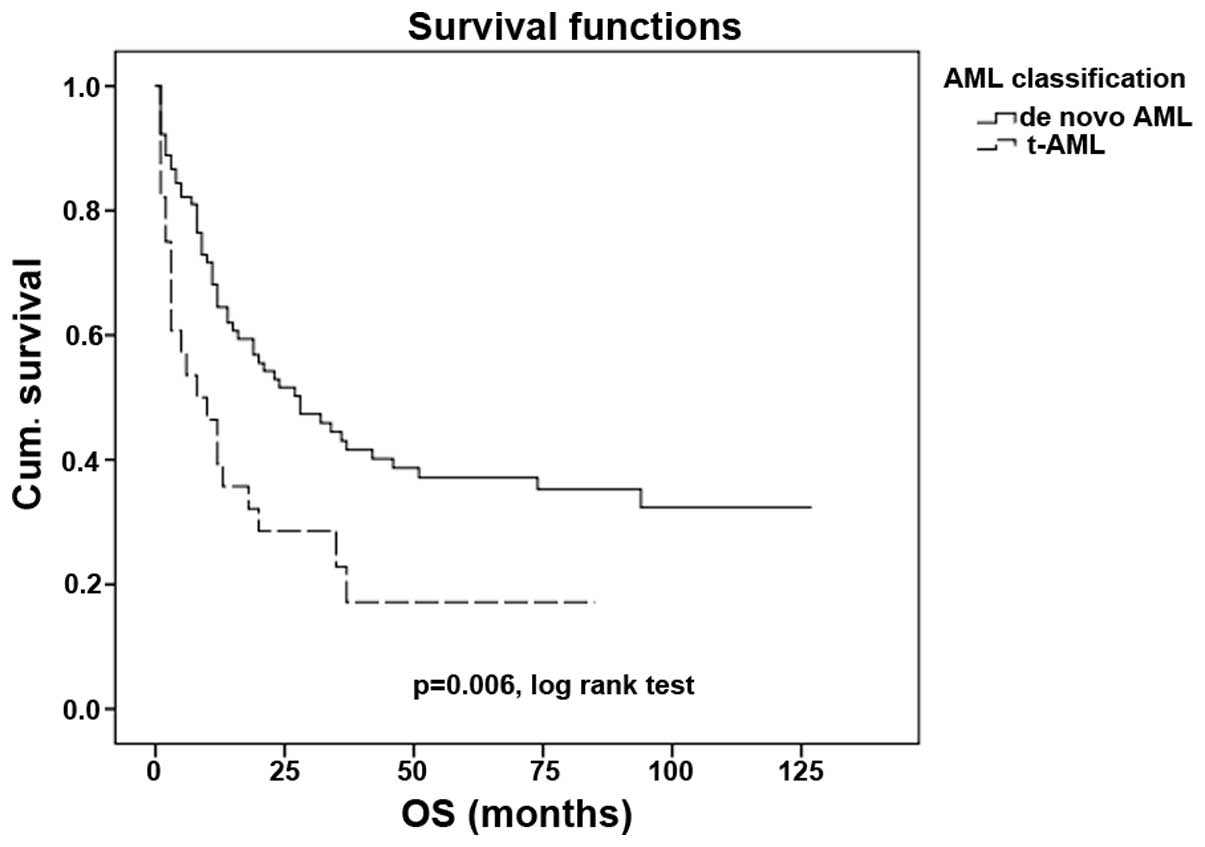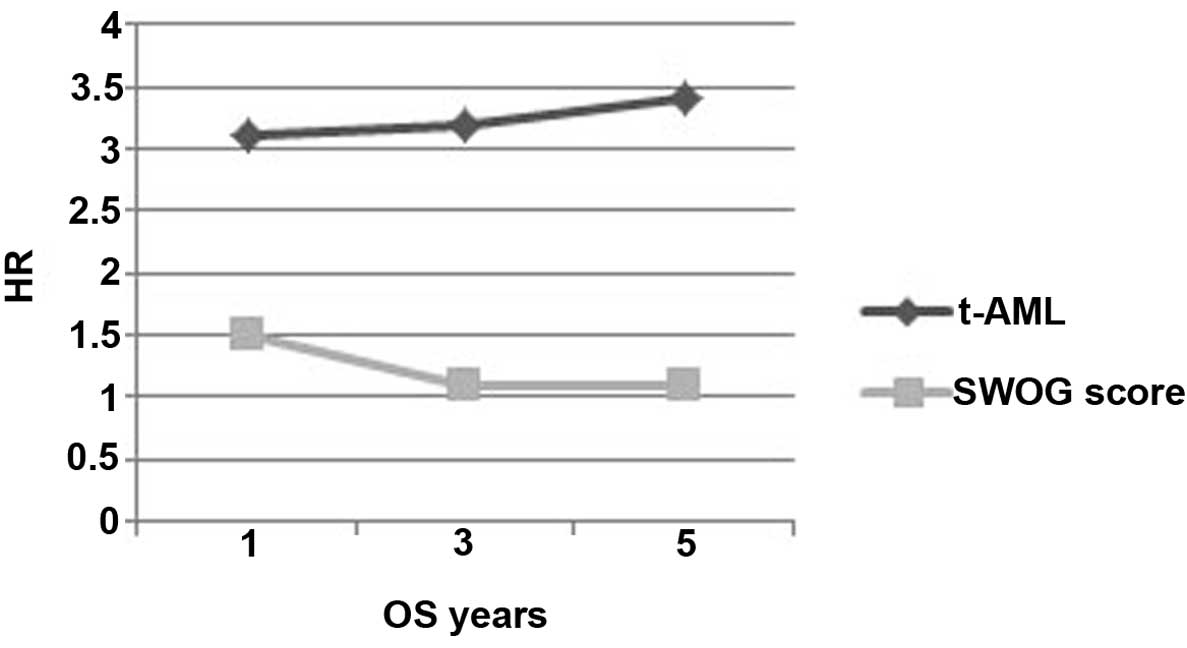|
1
|
Larson RA: Therapy-related myeloid
neoplasms. Haematologica. 94:454–459. 2009. View Article : Google Scholar : PubMed/NCBI
|
|
2
|
Morton LM, Dores GM, Tucker MA, Kim CJ,
Onel K, Gilbert ES, Fraumeni JF and Curtis RE: Evolving risk of
therapy-related acute myeloid leukemia following cancer
chemotherapy among adults in the United States, 1975–2008. Blood.
121:2996–3004. 2013. View Article : Google Scholar : PubMed/NCBI
|
|
3
|
Leone G, Fianchi L and Voso MT:
Therapy-related myeloid neoplasms. Curr Opin Oncol. 23:672–680.
2011. View Article : Google Scholar : PubMed/NCBI
|
|
4
|
Vardiman JW, Thiele J, Arber DA, Brunning
RD, Borowitz MJ, Porwit A, Harris NL, Le Beau MM,
Hellström-Lindberg E, Tefferi A and Bloomfield CD: The 2008
revision of the World Health Organization (WHO) classification of
myeloid neoplasms and acute leukemia: Rationale and important
changes. Blood. 114:937–951. 2009. View Article : Google Scholar : PubMed/NCBI
|
|
5
|
Vardiman JW, Harris NL and Brunning RD:
The World Health Organization (WHO) classification of the myeloid
neoplasms. Blood. 100:2292–2302. 2002. View Article : Google Scholar : PubMed/NCBI
|
|
6
|
Vardiman JW: The World Health Organization
(WHO) classification of tumors of the hematopoietic and lymphoid
tissues: An overview with emphasis on the myeloid neoplasms. Chem
Biol Interact. 184:16–20. 2010. View Article : Google Scholar : PubMed/NCBI
|
|
7
|
Leone G, Fianchi L, Pagano L and Voso MT:
Incidence and susceptibility to therapy-related myeloid neoplasms.
Chem Biol Int. 184:39–45. 2010. View Article : Google Scholar
|
|
8
|
Kayser S, Döhner K, Krauter J, Köhne CH,
Horst HA, Held G, von Lilienfeld-Toal M, Wilhelm S, Kündgen A,
Götze K, et al: German-Austrian AMLSG: The impact of
therapy-related acute myeloid leukemia (AML) on outcome in 2853
adult patients with newly diagnosed AML. Blood. 117:2137–2145.
2011. View Article : Google Scholar : PubMed/NCBI
|
|
9
|
Siegel R, Ma J, Zou Z and Jemal A: Cancer
statistics, 2014. CA Cncer J Clin. 64:9–29. 2014. View Article : Google Scholar
|
|
10
|
Siegel R, DeSantis C, Virgo K, Stein K,
Mariotto A, Smith T, Cooper D, Gansler T, Lerro C, Fedewa S, et al:
Cancer treatment and survivorship statistics, 2012. CA Cancer J
Clin. 62:220–241. 2012. View Article : Google Scholar : PubMed/NCBI
|
|
11
|
Wong TN, Ramsingh G, Young AL, Miller CA,
Touma W, Welch JS, Lamprecht TL, Shen D, Hundal J, Fulton RS, et
al: Role of TP53 mutations in the origin and evolution of
therapy-related acute myeloid leukaemia. Nature. 518:552–555. 2015.
View Article : Google Scholar : PubMed/NCBI
|
|
12
|
Li L, Li M, Sun C, Francisco L,
Chakraborty S, Sabado M, McDonald T, Gyorffy J, Chang K, Wang S, et
al: Altered hematopoietic cell gene expression precedes development
of therapy-related myelodysplasia/acute myeloid leukemia and
identifies patients at risk. Cancer cell. 20:591–605. 2011.
View Article : Google Scholar : PubMed/NCBI
|
|
13
|
Pedersen-Bjergaard J, Andersen MK,
Andersen MT and Christiansen DH: Genetics of therapy-related
myelodysplasia and acute myeloid leukemia. Leukemia. 22:240–248.
2008. View Article : Google Scholar : PubMed/NCBI
|
|
14
|
Pedersen-Bjergaard J, Pedersen M, Roulston
D and Philip P: Different genetic pathways in leukemogenesis for
patients presenting with therapy-related myelodysplasia and
therapy-related acute myeloid leukemia. Blood. 86:3542–3552.
1995.PubMed/NCBI
|
|
15
|
Brusamolino E, Gotti M and Fiaccadori V:
The risk of therapy-related myelodysplasia/acute myeloid leukemia
in Hodgkin lymphoma has substantially decreased in the ABVD era
abolishing mechlorethamine and procarbazine and limiting volumes
and doses of radiotherapy. Mediterr J Hematol Infect Dis.
4:e20120222012. View Article : Google Scholar : PubMed/NCBI
|
|
16
|
Brusamolino E, Baio A, Orlandi E, Arcaini
L, Passamonti F, Griva V, Casagrande W, Pascutto C, Franchini P and
Lazzarino M: Long-term events in adult patients with clinical stage
IA- IIA nonbulky Hodgkin's lymphoma treated with four cycles of
doxorubicin, bleomycin, vinblastine, and dacarbazine and adjuvant
radiotherapy: A single-institution 15-year follow-up. Clin Cancer
Res. 12:6487–6493. 2006. View Article : Google Scholar : PubMed/NCBI
|
|
17
|
Brusamolino E, Anselmo AP, Klersy C,
Santoro M, Orlandi E, Pagnucco G, Lunghi F, Maurizi-Enrici R,
Baroni CD, Lazzarino M, et al: The risk of acute leukemia in
patients treated for Hodgkin's disease is significantly higher aft
[see bined modality programs than after chemotherapy alone and is
correlated with the extent of radiotherapy and type and duration of
chemotherapy: A case-control study. Haematologica. 83:812–823.
1998.PubMed/NCBI
|
|
18
|
Delwail V, Jais JP, Colonna P and Andrieu
JM: Fifteen-year secondary leukaemia risk observed in 761 patients
with Hodgkin's disease prospectively treated by MOPP or ABVD
chemotherapy plus high-dose irradiation. Br J Haematol.
118:189–194. 2002. View Article : Google Scholar : PubMed/NCBI
|
|
19
|
Koontz MZ, Horning SJ, Balise R, Greenberg
PL, Rosenberg SA, Hoppe RT and Advani RH: Risk of therapy-related
secondary leukemia in Hodgkin lymphoma: The Stanford University
experience over three generations of clinical trials. J Clin Oncol.
31:592–598. 2013. View Article : Google Scholar : PubMed/NCBI
|
|
20
|
Eichenauer DA and Engert A:
Therapy-related myeloid neoplasms in patients treated for Hodgkin
lymphoma. Mediterr J Hematol Infect Dis. 3:e20110462011. View Article : Google Scholar : PubMed/NCBI
|
|
21
|
Godley LA and Larson RA: Therapy-related
myeloid leukemia. Semin Oncol. 35:418–429. 2008. View Article : Google Scholar : PubMed/NCBI
|
|
22
|
Rund D, Krichevsky S, Bar-Cohen S,
Goldschmidt N, Kedmi M, Malik E, Gural A, Shafran-Tikva S,
Ben-Neriah S and Ben-Yehuda D: Therapy-related leukemia: Clinical
characteristics and analysis of new molecular risk factors in 96
adult patients. Leukemia. 19:1919–1928. 2005. View Article : Google Scholar : PubMed/NCBI
|
|
23
|
Chen Y, Estrov Z, Pierce S, Qiao W,
Borthakur G, Ravandi F, Kadia T, Brandt M, O'Brien S, Jabbour E, et
al: Myeloid neoplasms after breast cancer: “Therapy-related” not an
independent poor prognostic factor. Leuk Lymphoma. 56:1012–1019.
2015. View Article : Google Scholar : PubMed/NCBI
|
|
24
|
Larson RA: Cytogenetics, not just previous
therapy, determines the course of therapy-related myeloid
neoplasms. J Clin Oncol. 30:2300–2302. 2012. View Article : Google Scholar : PubMed/NCBI
|
|
25
|
Olney HJ, Mitelman F, Johansson B, Mrózek
K, Berger R and Rowley JD: Unique balanced chromosome abnormalities
in treatment-related myelodysplastic syndromes and acute myeloid
leukemia: report from an international workshop. Genes Chromosomes
Cancer. 33:413–423. 2002. View Article : Google Scholar : PubMed/NCBI
|
|
26
|
Paschka P, Du J, Schlenk RF, Gaidzik VI,
Bullinger L, Corbacioglu A, Späth D, Kayser S, Schlegelberger B,
Krauter J, et al: Secondary genetic lesions in acute myeloid
leukemia with inv(16) or t(16;16): A study of the German-Austrian
AML Study Group (AMLSG). Blood. 121:170–177. 2013. View Article : Google Scholar : PubMed/NCBI
|
|
27
|
Churpek JE and Larson RA: The evolving
challenge of therapy-related myeloid neoplasms. Best Pract Res Clin
Haematol. 26:309–317. 2013. View Article : Google Scholar : PubMed/NCBI
|
|
28
|
Huh HJ, Lee SH, Yoo KH, Sung KW, Koo HH,
Kim K, Jang JH, Jung C, Kim SH and Kim HJ: Therapy-related myeloid
neoplasms in 39 Korean patients: A single institution experience.
Ann Lab Med. 33:97–104. 2013. View Article : Google Scholar : PubMed/NCBI
|
|
29
|
Schoch C, Kern W, Schnittger S, Hiddemann
W and Haferlach T: Karyotype is an independent prognostic parameter
in therapy-related acute myeloid leukemia (t-AML): An analysis of
93 patients with t-AML in comparison to 1091 patients with de
novo AML. Leukemia. 18:120–125. 2004. View Article : Google Scholar : PubMed/NCBI
|
|
30
|
Wang HC and Fedoroff S: Banding in human
chromosomes treated with trypsin. Nat New Biol. 235:52–54. 1972.
View Article : Google Scholar : PubMed/NCBI
|
|
31
|
Gonzalez Garcia JR and Meza-Espinoza JP:
Use of the International System for Human Cytogenetic Nomenclature
(ISCN). Blood. 108:3952–3953. 2006. View Article : Google Scholar : PubMed/NCBI
|
|
32
|
Slovak ML, Kopecky KJ, Cassileth PA,
Harrington DH, Theil KS, Mohamed A, Paietta E, Willman CL, Head DR,
Rowe JM, et al: Karyotypic analysis predicts outcome of
preremission and postremission therapy in adult acute myeloid
leukemia: A Southwest Oncology Group/Eastern Cooperative Oncology
Group Study. Blood. 96:4075–4083. 2000.PubMed/NCBI
|
|
33
|
Spruance SL, Reid JE, Grace M and Samore
M: Hazard ratio in clinical trials. Antimicrob Agents Chemother.
48:2787–2792. 2004. View Article : Google Scholar : PubMed/NCBI
|
|
34
|
Suvajdžić N, Cvetković Z, Dorđević V,
Kraguljac-Kurtović N, Stanisavljević D, Bogdanović A, Djunić I,
Colović N, Vidović A, Elezović I and Tomin D: Prognostic factors
for therapy-related acute myeloid leukaemia (t-AML) - a single
centre experience. Biomed Pharmacother. 66:285–292. 2012.
View Article : Google Scholar : PubMed/NCBI
|
|
35
|
Quesnel B, Kantarjian H, Bjergaard JP,
Brault P, Estey E, Lai JL, Tilly H, Stoppa AM, Archimbaud E,
Harousseau JL, et al: Therapy-related acute myeloid leukemia with
t(8;21), inv(16), and t(8;16): A report on 25 cases and review of
the literature. J Clin Oncol. 11:2370–2379. 1993.PubMed/NCBI
|
|
36
|
Larson RA and Le Beau MM: Prognosis and
therapy when acute promyelocytic leukemia and other “good risk”
acute myeloid leukemias occur as a therapy-related myeloid
neoplasm. Mediterr J Hematol Infect Dis. 3:e20110322011. View Article : Google Scholar : PubMed/NCBI
|
|
37
|
Feldman EJ: Does therapy-related AML have
a poor prognosis, independent of the cytogenetic/molecular
determinants? Best Pract Res Clin Haematol. 24:523–526. 2011.
View Article : Google Scholar : PubMed/NCBI
|
|
38
|
Grimwade D, Hills RK, Moorman AV, Walker
H, Chatters S, Goldstone AH, Wheatley K, Harrison CJ and Burnett
AK: National Cancer Research Institute Adult Leukaemia Working
Group: Refinement of cytogenetic classification in acute myeloid
leukemia: determination of prognostic significance of rare
recurring chromosomal abnormalities among 5876 younger adult
patients treated in the United Kingdom Medical Research Council
trials. Blood. 116:354–365. 2010. View Article : Google Scholar : PubMed/NCBI
|
|
39
|
Hospital MA, Prebet T, Bertoli S, Thomas
X, Tavernier E, Braun T, Pautas C, Perrot A, Lioure B, Rousselot P,
et al: Core-binding factor acute myeloid leukemia in first relapse:
A retrospective study from the French AML Intergroup. Blood.
124:1312–1319. 2014. View Article : Google Scholar : PubMed/NCBI
|
|
40
|
Solh M, Yohe S, Weisdorf D and Ustun C:
Core-binding factor acute myeloid leukemia: Heterogeneity,
monitoring, and therapy. Am J Hematol. 89:1121–1131. 2014.
View Article : Google Scholar : PubMed/NCBI
|
|
41
|
Duployez N, Willekens C, Marceau-Renaut A,
Boudry-Labis E and Preudhomme C: Prognosis and monitoring of
core-binding factor acute myeloid leukemia: Current and emerging
factors. Expert Rev Hematol. 8:43–56. 2015. View Article : Google Scholar : PubMed/NCBI
|
|
42
|
Foran JM: Frontline therapy of AML: Should
the older patient be treated differently? Curr Hematol Malig Rep.
9:100–108. 2014. View Article : Google Scholar : PubMed/NCBI
|
|
43
|
van der Holt B, Van den Heuvel-Eibrink MM,
Van Schaik RHN, van der Heiden IP, Wiemer EAC, Vossebeld PJM,
Löwenberg B and Sonneveld P: ABCB1 gene polymorphisms are not
associated with treatment outcome in elderly acute myeloid leukemia
patients. Clin Pharmacol Ther. 80:427–439. 2006. View Article : Google Scholar : PubMed/NCBI
|
|
44
|
Leith CP, Kopecky KJ, Chen IM, Eijdems L,
Slovak ML, McConnell TS, Head DR, Weick J, Grever MR, Appelbaum FR
and Willman CL: Frequency and clinical significance of the
expression of the multidrug resistance proteinsMDR1/P-glycoprotein,
MRP1, and LRP in acute myeloid leukemia: A Southwest Oncology Group
Study. Blood. 94:1086–1099. 1999.PubMed/NCBI
|
|
45
|
Benderra Z, Faussat AM, Sayada L, Perrot
JY, Tang R, Chaoui D, Morjani H, Marzac C, Marie JP and Legrand O:
MRP3, BCRP, and P-glycoprotein activities are prognostic factors in
adult acute myeloid leukemia. Clin Cancer Res. 11:7764–7772. 2005.
View Article : Google Scholar : PubMed/NCBI
|
|
46
|
Appelbaum FR, Kopecky KJ, Tallman MS,
Slovak ML, Gundacker HM, Kim HT, Dewald GW, Kantarjian HM, Pierce
SR and Estey EH: The clinical spectrum of adult acute myeloid
leukaemia associated with core binding factor translocations. Br J
Haematol. 135:165–173. 2006. View Article : Google Scholar : PubMed/NCBI
|
|
47
|
Schlenk RF, Benner A, Krauter J, Buchner
T, Sauerland C, Ehninger G, Schaich M, Mohr B, Niederwieser D,
Krahl R, Pasold R, et al: Individual patient data-based
meta-analysis of patients aged 16 to 60 years with core binding
factor acute myeloid leukemia: A survey of the German Acute Myeloid
Leukemia Intergroup. J Clin Oncol. 22:3741–3750. 2004. View Article : Google Scholar : PubMed/NCBI
|
|
48
|
Aldoss I and Pullarkat V: Therapy-related
acute myeloid leukemia with favorable cytogenetics: still
favorable? Leuk Res. 36:1547–1551. 2012. View Article : Google Scholar : PubMed/NCBI
|
|
49
|
Andersen MK and Pedersen-Bjergaard J:
Therapy-related MDS and AML in acute promyelocytic leukemia. Blood.
100:1928–1929. 2002. View Article : Google Scholar : PubMed/NCBI
|
|
50
|
Beaumont M, Sanz M, Carli PM, Maloisel F,
Thomas X, Detourmignies L, Guerci A, Gratecos N, Rayon C, San
Miguel J, et al: Therapy-related acute promyelocytic leukemia. J
Clin Oncol. 21:2123–2137. 2003. View Article : Google Scholar : PubMed/NCBI
|















